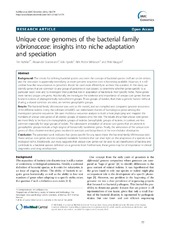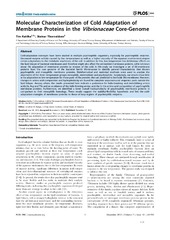| dc.contributor.advisor | Haugen, Peik | |
| dc.contributor.author | Kahlke, Tim | |
| dc.date.accessioned | 2013-07-04T12:40:45Z | |
| dc.date.available | 2013-07-04T12:40:45Z | |
| dc.date.issued | 2013-06-21 | |
| dc.description.abstract | In the presented work the bacterial family Vibrionaceae was used as a model to investigate
bacterial diversity on a gene level and to analyze the underlying concepts of
bacterial niche adaptation and evolution. For this, the genomes of a diverse dataset
of 64 Vibrionaceae isolates from various environments and temperature zones were analyzed using existing as well as newly developed bioinformatics tools. By building the pan-genome of the investigated isolates, i.e., determining the sets of shared and unique genes of each included isolate, the genetic diversity of members of this bacterial family was analyzed. Also, the distribution of the determined pan-genome on the chromosomes of all completely assembled genomes included in this study was analyzed with focus on speciation and evolution of Vibrionaceae. In a subsequent study general adaptation strategies of cold-adapted Vibrionaceae were investigated using membrane proteins that are conserved among all investigated isolates. In summary, the results presented in this thesis highlight the variety of different evolutionary processes that contribute to the adaptation and speciation of bacteria in general and Vibrionaceae in particular. | en |
| dc.description.doctoraltype | ph.d. | en |
| dc.description.popularabstract | Bakterier fra familien Vibrionaceae er svært utbredt globalt og fins i alle typer akvatiske miljøer fra Nordishavet til ferskvann i tropiske områder. De er mest kjent på grunn av at noen få arter forårsaker svært alvorlige sykdommer, for eksempel kolera. Majoriteten av arter i familien har imidlertid viktige og nyttige funksjoner i miljøet. Omdanning av lite tilgjengelige stoffer til næringsstoffer som kan utnyttes av marine dyr og planter er et eksempel på dette. Denne store diversiteten av livsstiler gjør at nettopp denne bakteriefamilien utgjør en attraktiv modell for studier av evolusjon og artsdannelse av bakterier.
I denne avhandlingen presenteres en sammenligning av arvestoffet til 64 representative bakterier fra familien Vibrionaceae. Spesielt er det lagt vekt på å kartlegge hvilke gener som er unike for hver enkelt bakterieart, og om dette kan brukes til å forklare bakteriens unike evner til å tilpasse seg spesifikke miljøer. Videre kan slike resultater potensielt vise seg svært nyttige i det videre arbeidet for utvikling av vaksiner, samt raske diagnostiske tester for identifisering av sykdomsfremkallende bakterier. | en |
| dc.description | Paper 2 of this thesis is not available in Munin: <br/>2. Tim Kahlke, Alexander Goesmann and Peik Haugen: 'The Vibrionaceae pan-genome hints at gene expression as the major driving force for unequal gene distributions on Vibrionaceae chromosomes' (manuscript) | en |
| dc.identifier.uri | https://hdl.handle.net/10037/5248 | |
| dc.identifier.urn | URN:NBN:no-uit_munin_4955 | |
| dc.language.iso | eng | en |
| dc.rights.accessRights | openAccess | |
| dc.rights.holder | Copyright 2013 The Author(s) | |
| dc.subject.courseID | DOKTOR-003 | en |
| dc.subject | VDP::Mathematics and natural science: 400::Basic biosciences: 470::Molecular biology: 473 | en |
| dc.subject | VDP::Matematikk og Naturvitenskap: 400::Basale biofag: 470::Molekylærbiologi: 473 | en |
| dc.title | Analysis of the Vibrionaceae pan-genome | en |
| dc.type | Doctoral thesis | en |
| dc.type | Doktorgradsavhandling | en |


 English
English norsk
norsk

